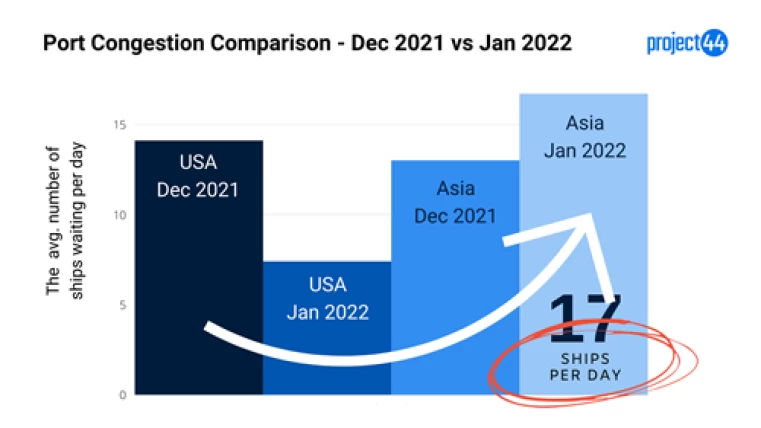January saw a reduction in port congestion in the US West and East Coast ports as workers cleared a substantial backlog amid Covid-19 outbreaks among port workers according to a new report from supply chain visibility data firm, project44 citing publications Courthouse News and Savannah CEO.
In a statement, it said that while there was "some easement" at US ports, including Los Angeles and Long Beach, congestion shifted to Asian ports.
According to project44, the number of ships waiting per day to berth at US ports, on average, fell from 14.1 ships in December to 7.4 in January while European ports also noted a month-to-month average decline from 6.5 ships per day in December to 5.6 ship per day in January.
Rise in Asia port congestion
However, it noted that from December to January, Asian ports, on average, recorded an increase from 13 ships per day to 16.7 per day.
Of the Asian ports, Hong Kong recorded the biggest increase, from an average of 17.5 ships per day in December to 22.5 in January, it added.
"This increase in congestion has been attributed to new COVID outbreaks in Asia and specifically in China," project44 said.
According to a Maersk news update, despite Covid-19 cases, container loading and discharge operations at ports and terminals have been working normally at the ports of Ningbo, Tianjin, Shenzhen, Dalian, and Guangzhou. However, the district-level lockdowns and mass testing led to warehouse closures and trucker shortages.
In Ningbo, for example, a cluster of Covid cases in early January in the city’s Beilun district led to extensive trucker delays as drivers had to undergo testing and quarantine before being allowed into Beilun’s three container terminals.
In Shenzhen, there were gate entry restrictions at the city’s Shekou terminal as health officials carried out testing after cases in Shenzhen.

project44 said January 2022 was also a "mixed bag" in terms of the time that ships spent in the port for container loading and unloading operations (berth time).
Compared to the 2021 average, the report noted that time at Vancouver jumped due to weather issues while the time that ships spent at berths in Long Beach and Los Angeles declined, in part due to a decline in import volumes in December and the ability of workers and road carriers to clear out containers during the month.
"While data indicates that there has been a very marginal decrease in the ship berth time in Los Angeles, the average time that a ship in Los Angeles spends at berth is 10 times more than it spends in Shanghai indicating the huge gap in port productivity at the largest port in the USA," the report added.
project44 also said that although there was a slight increase in available shipping capacity from December 2021 to January 2022 it was still at around 82% of the level seen in January 2021.
"While this slight increase from December to January proved beneficial for shippers needing to replenish inventories ahead of the Lunar New Year on February 1, the increase was not enough for retailers facing low inventory levels and strong demand," it said.
Container dwell times up
With the exception of some major Chinese ports, almost all global ports tracked by project44, export containers waited longer to leave ports versus import containers waiting for pick-up and delivery to customers.
The report said that this increase in export container dwell time may be attributed to the delay in the vessel's berthing which is caused by port congestion.
According to project44 intelligence, the import volumes into the US West Coast ports have been on a steady decline since August of 2021 and as a result of these declining volumes, the average import container dwell times dropped to 5.2 days and 5 days respectively in Long Beach and Los Angeles.
However, January export container dwell times for Los Angeles were much higher than import ones due to some carriers prioritizing empties over full export containers, project44 added.
For January, transshipment rollovers have "inched upwards" each month since October due to a number of reasons including blank sailings, port congestion and COVID and related labor issues, the report said.
It added that January's overall rollover percentage of 52%, was a bigger month-to-month increase compared to recent months, 6% higher than in December, likely due to Asian port congestion.
"The congestion at Asian ports was attributed to Omicron variant outbreaks and pre-Lunar New Year planning by carriers," it said.
Further port congestion likely
project44 noted that the period around the Lunar New Year is typically a "quiet period" for the ocean freight market due to the closure of many Asian manufacturing facilities in observance of the holiday.
"While the ocean freight market will likely see a slight lull during February, we expect demand will pick up once again once manufacturing facilities reopen. The potential for further port congestion is likely in the coming month as US retailers and other shippers replenish and increase safety inventories," it added.
Meanwhile, Josh Brazil, director of supply chain insights at project44 said in January there were "signs of improving conditions" at some ports, however, he noted that "we still have a ways to go before there is a return to normalcy."
"Whether or not there will be enough empty containers positioned in the right locations after the Lunar New Year is a big unknown right now. If they are not, we may see further delays," Brazil said.
"The Omicron variant of COVID-19 continues to impact port workers and other supply chain stakeholders. This will continue to impact supply chain operations around the world and will be a major contributor to delays," he added.


 (48)-x-large.webp)
